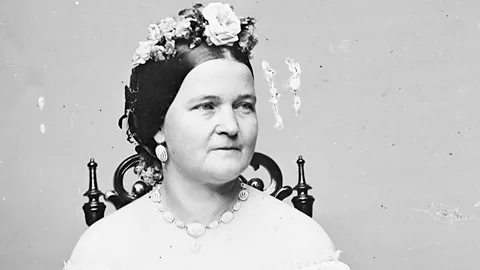 Library of Congress
Library of CongressAbraham Lincoln’s wife was long attacked for everything from her spending to her lack of emotional restraint. But with two new plays about her, she is finally getting better press.
During last month’s US presidential inauguration, as ever during these quadrennial celebrations, fierce interest focused on the First Lady. Much was made of Melania Trump’s dresses, her enigmatic smiles, and especially the navy-blue wide-brimmed boater-style hat she wore for the swearing-in. Was the hat a deliberate choice, to shield her face from the prying eyes of the public? No one could say, but legions speculated.
How unenviable is the lot of the President’s wife, lacking in formal power but constantly judged – expected to be immaculately turned out, and to remain, in conduct, ever above reproach. The court of public opinion has found no First Lady more wanting than Mary Todd Lincoln, wife of Abraham Lincoln. Her husband, who emancipated the slaves, and saved the union, enjoys near-universal adulation, while Mrs Lincoln has been the subject of criticism and disapproval since her first days in Washington in 1861 when she embarked on plans for a lavish redecoration of the White House. She travelled to New York for a shopping spree, and reporters followed her everywhere. One for The New York Herald wrote: “Mrs Lincoln, who has been engaged since her arrival in making large purchases at some of the leading merchants, was out yesterday enjoying herself in the usual way.”
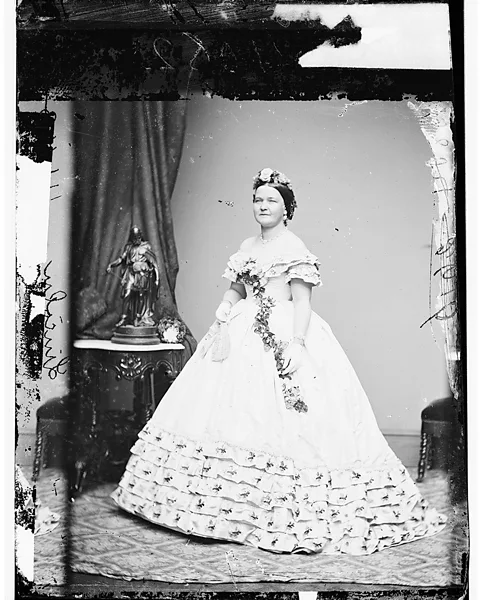 Library of Congress
Library of CongressSuch reports did not go down well in the besieged, wartime capital. Indeed, the loyalty of the First Lady, who hailed from a slave-holding family, and had three half-brothers in the Confederate Army, was questioned throughout the Civil War. Even after her husband was shot on 18 April 1865 by Confederate supporter John Wilkes Booth, as he sat beside her in Ford’s Theater, the public didn’t embrace their hero’s widow. In 1875, her own son had her committed to an insane asylum.
And yet today, in the era of TikTok, X, Instagram and Facebook, where social esteem rises and falls capriciously on clicks and likes, the maligned Mary Todd Lincoln is getting some compassionate reassessment on the stage, most particularly in Mrs President, a new play by US historian, writer and artist John Ransom Phillips opening this week at London’s Charing Cross Theatre.
Her theatrical redemption
This two-hander centres on the relationship between Mary Todd Lincoln (played by Miriam Grace Edwards), and William Brady, considered the father of American photo-journalism (Sam Jenkins Shah) who took iconic pictures of Abraham Lincoln, his family, and the battlefields of the bloody US Civil War. The new play imagines the First Lady, coming to Brady’s studio to sit for her portrait, aware that she is an object of suspicion because of her southern heritage, and seeking an “image that will define history’s view of me”. Brady declares he has the power to do that. “I shape the image of people who shape America. Past. Present. Future,” he says.
In Ransom Phillips’ depiction, Mrs Lincoln demands to be addressed as Mrs President, and engages in an on-going verbal tug of war with Brady over how she should be portrayed. The play asks who controls the revelatory public image, the subject or the artist? This question transcends time and place, but has specific resonance for the former First Lady who sought, and believed she never received, proper recognition during her life for all she had done, and suffered. Later scenes follow Mrs Lincoln into her widowhood, and other controversial historical figures of mid-19th-Century America – abolitionist John Brown, Chief Justice Roger Taney, and naturalist John James Audubon – appear on stage, depicted by Shah. Mrs President is a daringly kaleidoscopic look at the ownership of self.
In truth, Mary Todd Lincoln and Matthew Brady’s relationship was a limited one. She did pose for Brady at his studio at 625 Pennsylvania Avenue in November of 1861. When she saw the photographs, she was unhappy with how she looked and instructed that they all be destroyed, except for one she deemed “passable”, in which she stands, and her face is seen in profile; Brady ignored this request and kept all the photographs in his archives. And later in Lincoln’s term, she returned to the studio a few times, but it’s not known if Brady took any other of her portraits, as he deputised much studio work to his assistants.
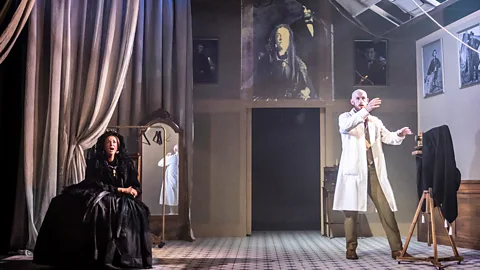 Pamela Raith
Pamela RaithRansom Philips tells the BBC his aim with the play wasn’t to document history but rather “to rescue Mary Todd Lincoln from ridicule and caricature, and to show her as fully a person, a woman of complexity and depth of feeling – possessing the kind of emotionality that men often lack”. And his view of Brady is not totally benign. “Brady is an artist, like I am, and I know artists can be tyrannous.”
In a wildly different way, another theatre production currently running in New York is also sympathetic to the 16th First Lady. Oh, Mary! has been a huge word-of-mouth hit since it first premiered at the city’s Lucille Lortel Theatre in February 2024, before transferring to Broadway in the summer. This comedy, written by Cole Escola and described by The New York Times as “gleefully tasteless” and an “unhinged historical fantasia”, depicts Mary as a lascivious, self-centered alcoholic who yearns to escape the White House and her nasty, neglectful husband so as to become a cabaret star. Until Escola turned over the role to Betty Gilpin last month, they themselves starred as Mary – in drag, shaking a mop-like wig of black barrel curls. All joking aside, and Oh, Mary! has numerous slapstick moments, the play’s inspiration was Escola’s own sense of identification with Mary – a woman who could be “too much” and was “trapped in this role she was wrong for”, as Escola explained in an interview on NPR last year.
The questions that linger
Perhaps unintentionally, Escola and Phillips have joined a century-long debate among historians over how Mary Lincoln should best be understood. Was she an energetic, ambitious young woman who recognised genius in Lincoln, a rough-hewn country lawyer, and propelled him to greatness? Or was she a volatile wife who made Lincoln’s domestic life a living hell, hurling accusations – and on occasion crockery – at him during regular fits of rage? Was she first unhinged by grief in 1850, when she lost her son Eddie at age three to tuberculosis? Or was it the loss of a second son, Willy, 12 years later, that really drove her mental health decline? Did she take bribes and pad expense accounts as First Lady? Or did she act as a valuable helpmeet, giving President Lincoln sage advice?
“In the public imagination she’s multiple people – it all depends on who is examining her,” historian Jason Emerson tells the BBC. Author of seven books on the Lincoln family, including The Madness of Mary Lincoln, Emerson is currently assembling a complete volume of the former First Lady’s letters for the Lincoln Studies Center of the University of Illinois. “Mary was a complex person, very human, and she made mistakes, as Lincoln did too. She is essentially a tragic figure.”
Loss haunted Mary’s life starting at the age of six, when her mother died. After Mary’s father remarried and sired nine children with his new wife, love was a scant commodity in the family home in Lexington, Kentucky. Mary escaped to Springfield, Illinois, where she lived with her elder sister. Vivacious in conversation and praised, too, for her pretty face and milky complexion, young Mary had many admirers. She found in Lincoln a man who shared her passion for poetry, theatre and Whig politics, and who was also nearly 10 years older and more than a foot taller. But rather than provide her with the steady paternal affection she missed out on as a child, Lincoln was often away from home, working as a lawyer on the Illinois judicial circuit. As introverted as his wife was extroverted, Lincoln struggled to respond to her emotional pleas for attention and sympathy.
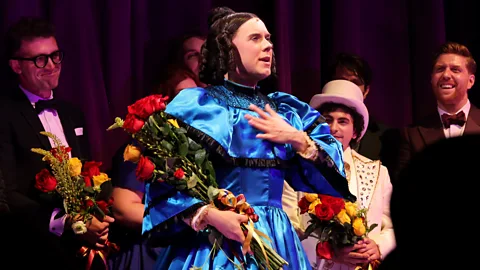 Getty Images
Getty Images“Temperamentally they were very different,” Emerson says. “And as she aged, her mental problems got worse, consistent with bi-polar issues.” Emerson’s study of Mary Lincoln and her extended family has convinced him that she suffered from the condition formerly known as manic depressive disorder, not widely diagnosed in the 19th Century.
The stresses on both Lincolns during their time in wartime Washington were immense, and Mary was determined to dress fashionably and entertain lavishly. “She thought of herself as the Queen of America, doing what she was supposed to do as First Lady” says Emerson. “Her narcissism was perhaps her greatest vulnerability.” But when their son Willie succumbed to typhoid in 1862, she refused to get out of bed for weeks and grieved so copiously her husband rebuked her.
Perhaps it was inevitable that this often unrestrained woman, would continue to get bad press after her death in 1882. William Herndon, Lincoln’s law partner, reinforced the most unflattering views of Mary Lincoln, in the biography he co-wrote in 1889 titled Herndon’s Lincoln: The True Story of a Great Life. Herndon and Mary despised each other during Lincoln’s lifetime and competed for his attention. In private Herndon called her a “she-wolf”.
For many decades, Herndon’s interpretation stood – Mary Todd Lincoln was regarded as a harridan married to a saint. But in the 1980s and 1990s, when scholars began to seriously reassess the role of women in history, the troubled First Lady got a fresh look. In 1987, Jean Baker, a historian at Maryland’s Goucher College published Mary Todd Lincoln: A Biography, portraying the Lincoln marriage as fundamentally tolerant and loving, and Mary as a vital, behind-the-scenes participant in her husband’s political career, consoling, advising and encouraging.
That view in turn, was contradicted by renowned Lincoln scholar Michael Burlingame in his 2021 book An American Marriage: The Untold Story of Abraham Lincoln and Mary Todd. Burlingame believes Lincoln was made miserable by his wife, who, he believes, at times physically abused him, and posits she seduced Lincoln to force him to marry her – they were wed on a day’s notice, their first child born a scant nine months later. And Burlingame is certain, based on evidence in US government archives, that she solicited bribes and sold permits and pardons while in the White House. Yet, the author credits Mary with fuelling Lincoln’s rise. “If he hadn’t married a woman who was so ambitious and so willing to prod her husband and to goad him… he may not have gone as far as he did,” the historian said in a recent interview for the History Unplugged podcast. Moreover, Lincoln’s remarkable ability to deal with difficult people, a gift constantly on display during his Presidency, had been honed by plenty of practice at home, in Burlingame’s view.
Author, too, of the definitive Abraham Lincoln: A Life, (2009) Burlingame was among numerous experts consulted by director Steven Spielberg for his 2012 hit film, Lincoln, starring Daniel Day-Lewis as the president and Sally Field as Mary Lincoln. The film portrays the First Lady in a generally positive light, and husband and wife as closely bonded. And yet Burlingame realised that Spielberg and scriptwriter Tony Kushner had closely studied his biography – which included his hypothesis about the hasty Lincoln wedding – when Day-Lewis (as Lincoln) and Field (as Mary Lincoln) argue over their eldest son Robert joining the army. He’s in favour, she’s opposed, and Mary accuses her husband of never liking the boy. “You’ve always blamed Robert for being born, for trapping you in a marriage that’s only ever given you grief,” she says. “I almost fell out of my seat,” the historian recalled on the podcast.
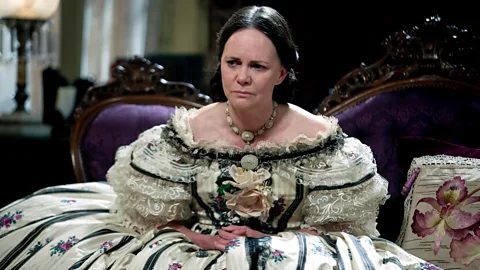 Alamy
AlamyBut even Burlingame at his most critical considers Mary Todd Lincoln more to be pitied than despised, considering that three of her four sons predeceased her, and her husband was murdered before her eyes. And it’s one of the pleasures of the play Mrs President to see the heroine put up a fight for her own identity, and ignore the often harsh and deprecating judgements rained down upon her both before and after her death.
Mrs President is at Charing Cross Theatre, London until March 16. Oh Mary! is booking at the Lyceum Theatre, New York until 28 June.





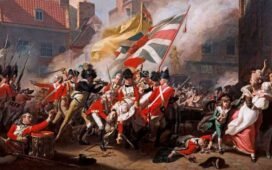
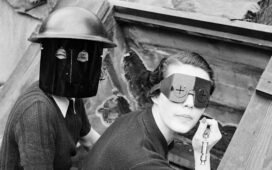


Recent Comments